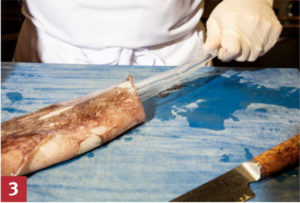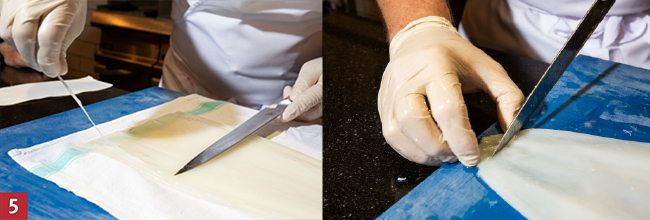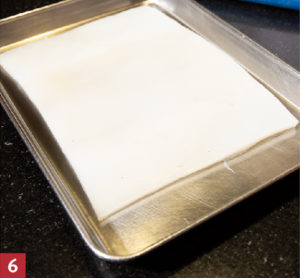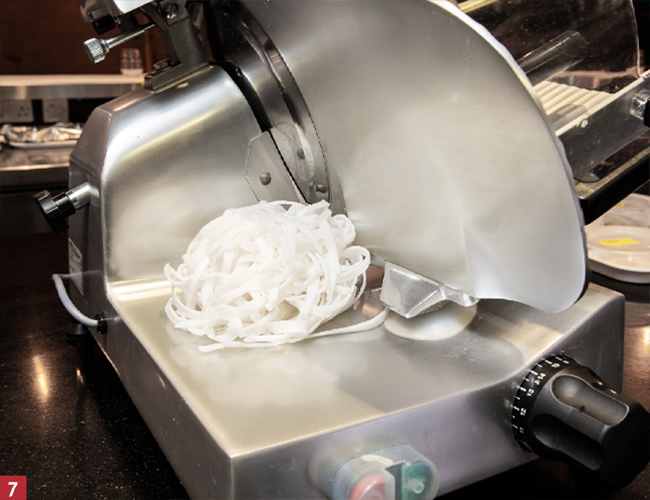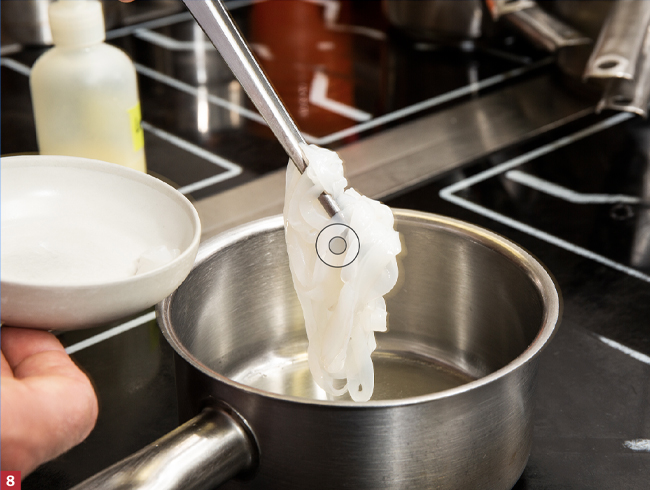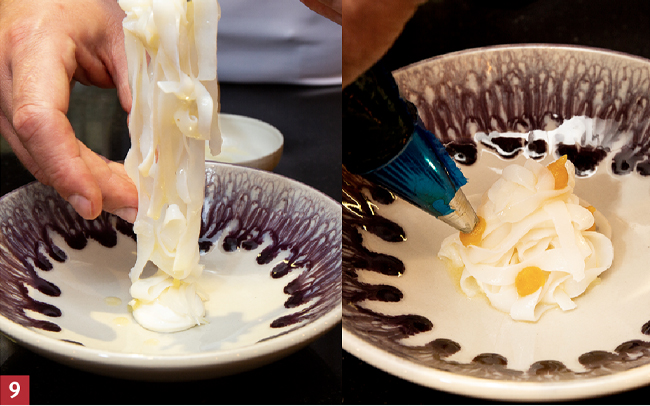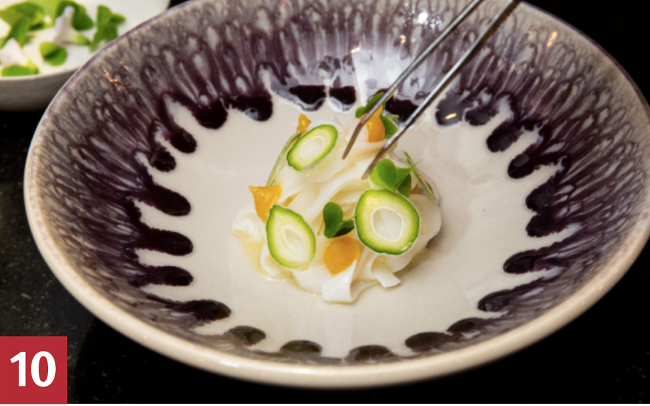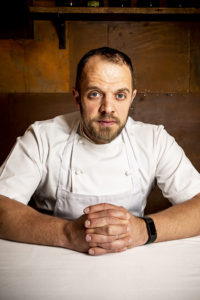You never know what you're going to get at James Knappett's Kitchen Table, where a daily changing menu showcases impeccable produce – in this case, squid, cooked delicately and served with zingy Meyer lemon jam. Michael Raffael reports
Think of the giant squid in 20,000 Leagues Under the Sea and it's easy to imagine weaving tentacles and one outsize eye attached to a tapering, tubular body.
Think of squid as seafood and chances are most people will have a mental image of battered and fried rubbery rings. It's a blinkered view. Except in a perfect Venetian fritto misto, the cooking technique does the poor cephalopod few favours. The Japanese do better: they grill it or eat it as raw sashimi. Or go to the Basque country for a bowl of chipirones - finger-length 'squidlings' stewed in their ink - or the stuffed version in Italy.
At Kitchen Table, the 20-seat restaurant at the rear of Bubbledogs on Charlotte Street in Fitzrovia, head chef James Knappett steps outside the box. He's not reworking a recipe borrowed from another cuisine; instead, he's starting from scratch, going back to the raw material and asking himself questions about the taste and texture. At its freshest and at a specific size, squid is more than a wad of bland protein. It doesn't have to be hockey-puckish when cooked; it can be al dente like pasta - and, like pasta, it can absorb other flavours without losing its identity.
Knappett's approach lends itself to the small portions served on his tasting menu. The quantity, more than a mouthful and less than a plateful, delivers an impact without overwhelming the eater.
Sourcing
Choose line-caught (jigged) European squid with a mantle that's more than 30cm long. It has to be perfectly fresh, with bright eyes, no fishy smell and a naturally slippery skin. The skin colour may vary because it's part of a cephalopod's camouflage.
Planning
- Make the Meyer lemon jam
- Clean and trim the squid
- Freeze
- Slice
- Sweat the squid
- Plate
Batch size and portion
To prepare the squid ribbons, work with mantles from seven to 10 European squid. For each portion Knappett uses about 75g of prepared ribbons.
Cost
The squid dish forms part of Kitchen Table's 12-course, daily changing menu, which costs £150 per head.
Preparation
Note: For this recipe Knappett doesn't use the legs, tentacles, 'wings' or ink. These may all be used in other dishes.
You will need a meat slicer for this recipe.
Separate the mantle from the head, legs, tentacles and innards (1). Pull off the mottled skin and wings (2). Pull out the quill, the cellophane-transparent bone that lies along the back of the mantle (3).
Split the mantle down the natural line of the backbone.
Open out the mantle on the work surface. Scrape off the slippery membrane. Turn the mantle over and repeat (4).
Dry both surfaces with a J-cloth and/or tea towel. It should be perfectly dry.
Trim the squid to form a neat rectangular shape (5).
Layer up to 10 squid rectangles on top of each other. Blast freeze at -25°C (6).
Set the meat slicer to .5 (about 5mm). Place the block of squid sheets in the machine. Slice long ribbons that look like fettucine (7). Refrigerate, covered, ahead of service.
Squid
Serves 1
- 20g rendered chicken fat
- 5g butter
- 75g squid ribbons
- Salt
- Meyer lemon juice
- 10g Meyer lemon jam (see below)
- 1tbs grelot onions (see note)
- 1 green almond
- Fresh oxalis leaves
Melt the chicken fat and butter in a pan. As soon as the butter melts, add the squid and warm it through (8). Season with salt. Add Meyer lemon juice to taste.
Pipe a whorl of Meyer jam in the centre of the plate, and add three or four grelot onion slices on top. Arrange the squid on top and finish with dabs of Meyer lemon jam (9), slices of green almond and oxalis leaves and flowers. Dust with powdered salt crystals (10).
Note: for this recipe, Grelot (ie pearl) pickling onions are macerated in equal quantities of sugar, water and Champagne vinegar.
Anatomy of a squid
In the UK squid range from a few centimetres to giants up to 50cm long. Fishermen catch two kinds in UK waters: alloteuthis subulata, the common squid, which grows to around 20cm, and loligo vulgaris, the European squid, which has a mantle between 30cm and 50cm long and broad fins.
The key anatomical parts of the squid are:
The mantle: the large pocket with two fins or wings attached to it.
The head: with eyes, eight arms and two tentacles.
Internal shell: the transparent 'quill' that has to be removed. It attaches to the mantle.
Internal organs: liver, stomach, hearts - a squid has two branchial hearts and one systemic heart - gills and also the ink sac.
Meyer lemon jam
When Knappett and his wife Sandia Chang, his partner in Kitchen Table and Bubbledogs, go to Los Angeles, they bring back 300 Meyer lemons from his mother- in-law's garden.
Before leaving he zests them and scrapes off any pith and squeezes the juice to obtain 4 litres. At Kitchen Table he uses the whole fruit to make lemon jam, which is sweeter than normal lemons with notes of bergamot.
For 20 lemons
- 20 lemons
- 500ml 50/50 sugar and water stock syrup
- 1tbs neutral (eg grapeseed) oil
- Meyer lemon juice to taste
Zest the lemon and scrape away any remaining pith. Drop in the cold syrup and bring to the boil. Remove the zests. Repeat the process and then poach the zests till they soften. Strain and blend in a Vitamix, adding the oil and lemon juice to taste. Transfer to a squeezy bottle or piping bag.
James Knappett baulks at the suggestion that he's been round the block. "Most chefs," he says, "have worked in more than a dozen kitchens; I've been in five."
And what a five: Gordon Ramsay at Royal Hospital Road ("he was still cooking the meat"), Rick Stein in Padstow, Marcus Wareing at the Berkeley, two years at Noma in Copenhagen and finally two years at Per Se in New York.
It's a pedigree that helps to explain Kitchen Table's success: achieving a Michelin star in 2014, followed by a coveted second four years later. It also points to his reasons for ditching the traditional structures of his craft.
Before Knappett opened six years ago, he was ready to quit cooking professionally. He hadn't burnt out or lost his creative appetite; he was out of patience with the way high-end dining operates: "It was robotic. Chefs go in to work in the morning and prep the food for lunch. We never see the guest. We never know whether they're loving it, except when a waiter comes back and says: 'Table five sends its compliments to the chef.' And after lunch, we clean down and do the whole thing over again in the evening."
The monotony extended, at least in his case, to the dishes being prepared. He recalls his time at Marcus Wareing, where he started as a commis and finished as head chef: "We had four menus a year. When they changed chefs loved it. The dishes were new and there was a buzz in the kitchen. After a month everyone was like, 'Ugh, another scallop dish'… 'another sea bass'."
Haute cuisine based itself on the premise that kitchens operated to a brigade structure, where everyone knew their place, and routine was key to maintaining quality. That doesn't work any more. No apprentice will chop parsley for a year before graduating to onions; no commis aspires to be the saucier in the same kitchen 30 years down the line.
At Kitchen Table guests sit at a U-shaped counter watching chefs perform. It's theatrical, but Knappett argues that it bridges the buyer-seller gap.
"I want to tell them that the squid comes off a day-boat or that those beautiful lemons came from my mother-in-law's garden in LA. If the chefs tell the diners what they've made it's a lot easier than the waiters doing it, as they would have to memorise 20 dishes."
Knappett has avoided the risk of menu fatigue by scrapping it. Even the blackboard listing one-word pointers to each course has gone. "We never do the same menu twice. Every day is a fresh start, because we're always cooking new dishes. So my guys tonight won't be repeating what they've done before, even if it's just a change to the garnish."
The format is unforgiving. Beyond the public gaze there are always 'solutions' to 'problems' in most kitchens. If the dinner costs £150 and every part of the meal is in full view, unforced errors or accidents cease to be an option. "At 5.30pm, my head chef Tom Spenceley has to check everything - down to the individual oxalis leaves that my other chefs have foraged," he says.
Knappett learned how to achieve that polish from his spell at three-Michelin-starred Per Se, an iconic restaurant serving hundreds of covers daily. "It taught us the art of finesse, from how clean your apron is to the appearance of your fingernails or the way the pass has to remain immaculate. All that relays into the food."
Kitchen Table limits itself to 20 covers and is booked out months ahead. Knappett recognises that the tasting menu format can be abused by chefs lacking the ability to pull it off. In London, where there is so much choice, it isn't an issue: "If the style of a three- to four-hour meal isn't what you like, don't come to my restaurant."
Continue reading
You need to be a premium member to view this. Subscribe from just 99p per week.
Already subscribed? Log In



